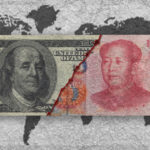Institutional Investors Turn To Gold

( February 9th 2021 - Kelsey Rolfe, via The Northern Miner)
In the face of historically low interest rates and chronically depressed bond yields, institutional investors are turning to gold as a portfolio diversifier.
Gold has been largely shunned by institutional investors for decades, with bonds providing more substantial yields. Seen as the domain of retail investors, gold doesn’t have an income stream and comes with storage costs.
But as central banks around the world created more accommodative monetary policy in the face of the Covid-19 pandemic — driving already low interest rates even lower and pushing bond yields to near-zero — owning gold is starting to make more sense. Bonds, long used in the portfolio as a diversifier and a hedge against equity market volatility, no longer offer the same level of protection.
“As bond yields have come down, the arguments against gold have started to weaken — there’s not much income from bonds either,” Calum Mackenzie, partner and head of investment for Canada at global consultancy Aon, said in an interview. “Investors looking for that downside protection and that portfolio diversifier that bonds used to provide, they’re looking at gold.”
Gold tends to have an inverse relationship to public equities, providing a buffer against market volatility. It also does well in inflationary scenarios, as the degrading value of the U.S. dollar pushes its price higher. And an inflation surprise is something that’s certainly on the minds of investors in the wake of a period of highly unconventional monetary policy, and the United States Senate’s recent approval of a US$1.9-trillion stimulus package.
“Yes, the rollout of the vaccine is reducing risk and giving hope that the worst is behind us in terms of the pandemic. But at the same time, the pandemic has created a lot of unintended consequences in terms of real economic impact and how long it takes to recover from that,” Juan Carlos Artigas, head of research at the World Gold Council, said in an interview.
He pointed to the global financial crisis as an example: while the economy did start to recover in 2009, it wasn’t until a year later that the European debt crisis kicked in. “In the same way, right now even though the recovery is happening, there are still a lot of things we don’t quite understand about what the Covid-19 pandemic created,” he said.
As well, unlike fiat currency, as a hard currency gold is naturally scarce. While mine production has increased by approximately 1.6% per year for the past 20 years, consumers, investors and central banks have kept demand high, the World Gold Council said.
Gold prices began rallying in 2019 and reached an all-time high of US$2,000 an ounce in mid-2020. They’ve since consolidated around US$1,800 an ounce. In its 2021 outlook, the World Gold Council called the metal one of the best-performing assets of 2020, outperforming the S&P 500, global treasuries, international and emerging market stocks, as well as commodities and oil. It anticipated “the need for effective hedges and the low-rate environment will keep investment demand [for gold] well supported.”
And according to global investment management firm PIMCO, even at those prices gold still shines. According to an August 2020 blog by PIMCO portfolio manager Nicholas Johnson, gold is “attractively valued — one might even say cheap — in the context of historically low real interest rates.”
In the past year, multiple investors, pensions and global banks have added gold to their portfolios. Lombard Odier & Cie SA, a Swiss private bank, added gold to its strategic asset allocation in July 2020, and the following month the Ohio Police & Fire Pension Fund, which manages $16.5 billion in assets under management, reported adding a 5% allocation to gold. Investment managers Mason Capital Partners, Sandell Asset Management and Caxton Associates all initiated new positions in gold ETF SPDR Gold Trust in August 2020.
Research from the World Gold Council found that in the first 10 months of 2020, gold-backed ETFs had “record-setting inflows” and investment demand for gold through ETFs was a primary driver of overall gold demand. Global assets under management in gold-backed ETFs stand at 3,765 tonnes as of February 2021, worth US$226 billion.
While the pandemic prompted some investor interest, others were buying gold well before the crisis. OPTrust, one of Canada’s largest pension funds with almost $22 billion in net assets, began investing in gold futures in 2019 in response to the low interest rate environment, and added to its allocation in early 2020, as well as during the pandemic. The fund holds gold in its risk mitigation portfolio, which aims to protect the plan from macroeconomic risks such as inflation or stagflation.
“It wasn’t pandemic related; our decision to invest in gold [came from] looking at the big picture in terms of our overall plan sustainability and the environments we might face in the future,” OPTrust chief investment officer James Davis said in an interview. “One thing we need to be sustainable is we need a portfolio that’s resilient. There are certain types of economic environments that are more challenging for defined benefit pension plans, and investing in gold can help to mitigate some of those challenges.”
Mackenzie said Aon’s clients have largely implemented gold in “opportunistic” or tactical asset allocation portfolios, where it’s being held for the short-term.
“There will be a time when the market conditions normalize … and you can go back to a world where there’s a clearer relationship between equities and bonds, [with bonds] providing strong downside protection,” he said. “As such, gold may be a transitionary hold in a portfolio that we monitor regularly.”
Meanwhile, PIMCO sees gold as having long-term value. In the company’s 2021 asset allocation outlook, Geraldine Sundstrom and Erin Browne, both managing directors and portfolio managers focused on asset allocation strategies, wrote that while safe government bonds continue to be a reliable source of diversification, gold, as both an inflation hedge and diversifier, “provides a good store of value over the long term with a low correlation to traditional risk assets.”
OPTrust is also investing for the long haul. “With uncertainties in the economic environment that we feel will be there for the next several years, we’re not anticipating reducing our gold exposure,” said Davis. “In that kind of environment where we anticipate economic uncertainty [will be] abundant over the coming years, and probably the coming decade, owning gold will add to the resilience of the portfolio.”






